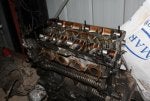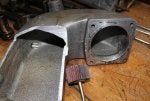OK: My GTV T-S does not go fast enough (particularly now that my wife bought a diesel BMW that will blow it into the weeds), and blows some smoke.
Recently I bought a 75 T-S parts car (that just happened to be one I knew very well years ago) with 350,000 km on it. So with a spare engine, I thought I do a bit of head work, throw some rings in and see what happens when combined with my BBR superchip to get me by until I have time to build a decent engine.
First bit of fun was getting the head off that had NEVER been off in 24 years and did not appear to have ever had much in the way of coolant. It was a very grubby engine indeed: but after making a puller and spending a few hours it came off.
![]()
The intake manifold took a couple of hours to remove itself (will have to replace all studs. Head has some corrosion that will need a bit of repair. Porting started:
![]()
Why stop at the head... If you are porting the head: do the manifold runners too. But how do you do that? Have you ever wondered how rough the inside of the runners are in a Twin Spark manifold? The answer: Very!
![]()
![]()
The inside of the plenum is not that important. But will probably do some work here too.
![]()
Recently I bought a 75 T-S parts car (that just happened to be one I knew very well years ago) with 350,000 km on it. So with a spare engine, I thought I do a bit of head work, throw some rings in and see what happens when combined with my BBR superchip to get me by until I have time to build a decent engine.
First bit of fun was getting the head off that had NEVER been off in 24 years and did not appear to have ever had much in the way of coolant. It was a very grubby engine indeed: but after making a puller and spending a few hours it came off.

The intake manifold took a couple of hours to remove itself (will have to replace all studs. Head has some corrosion that will need a bit of repair. Porting started:

Why stop at the head... If you are porting the head: do the manifold runners too. But how do you do that? Have you ever wondered how rough the inside of the runners are in a Twin Spark manifold? The answer: Very!


The inside of the plenum is not that important. But will probably do some work here too.




























